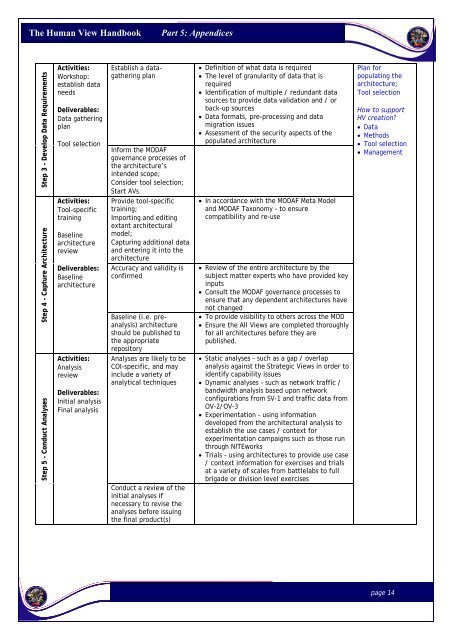The Human View Handbook for MODAF: Part V â Appendices
The Human View Handbook for MODAF: Part V â Appendices
The Human View Handbook for MODAF: Part V â Appendices
You also want an ePaper? Increase the reach of your titles
YUMPU automatically turns print PDFs into web optimized ePapers that Google loves.
<strong>The</strong> <strong>Human</strong> <strong>View</strong> <strong>Handbook</strong><br />
<strong>Part</strong> 5: <strong>Appendices</strong><br />
Step 3 – Develop Data Requirements<br />
Step 4 – Capture Architecture<br />
Step 5 – Conduct Analyses<br />
Activities:<br />
Workshop:<br />
establish data<br />
needs<br />
Deliverables:<br />
Data gathering<br />
plan<br />
Tool selection<br />
Activities:<br />
Tool-specific<br />
training<br />
Baseline<br />
architecture<br />
review<br />
Deliverables:<br />
Baseline<br />
architecture<br />
Activities:<br />
Analysis<br />
review<br />
Deliverables:<br />
Initial analysis<br />
Final analysis<br />
Establish a datagathering<br />
plan<br />
In<strong>for</strong>m the <strong>MODAF</strong><br />
governance processes of<br />
the architecture’s<br />
intended scope;<br />
Consider tool selection;<br />
Start AVs<br />
Provide tool-specific<br />
training;<br />
Importing and editing<br />
extant architectural<br />
model;<br />
Capturing additional data<br />
and entering it into the<br />
architecture<br />
Accuracy and validity is<br />
confirmed<br />
Baseline (i.e. preanalysis)<br />
architecture<br />
should be published to<br />
the appropriate<br />
repository<br />
Analyses are likely to be<br />
COI-specific, and may<br />
include a variety of<br />
analytical techniques<br />
Conduct a review of the<br />
initial analyses if<br />
necessary to revise the<br />
analyses be<strong>for</strong>e issuing<br />
the final product(s)<br />
• Definition of what data is required<br />
• <strong>The</strong> level of granularity of data that is<br />
required<br />
• Identification of multiple / redundant data<br />
sources to provide data validation and / or<br />
back-up sources<br />
• Data <strong>for</strong>mats, pre-processing and data<br />
migration issues<br />
• Assessment of the security aspects of the<br />
populated architecture<br />
• In accordance with the <strong>MODAF</strong> Meta Model<br />
and <strong>MODAF</strong> Taxonomy - to ensure<br />
compatibility and re-use<br />
• Review of the entire architecture by the<br />
subject matter experts who have provided key<br />
inputs<br />
• Consult the <strong>MODAF</strong> governance processes to<br />
ensure that any dependent architectures have<br />
not changed<br />
• To provide visibility to others across the MOD<br />
• Ensure the All <strong>View</strong>s are completed thoroughly<br />
<strong>for</strong> all architectures be<strong>for</strong>e they are<br />
published.<br />
• Static analyses – such as a gap / overlap<br />
analysis against the Strategic <strong>View</strong>s in order to<br />
identify capability issues<br />
• Dynamic analyses – such as network traffic /<br />
bandwidth analysis based upon network<br />
configurations from SV-1 and traffic data from<br />
OV-2/OV-3<br />
• Experimentation – using in<strong>for</strong>mation<br />
developed from the architectural analysis to<br />
establish the use cases / context <strong>for</strong><br />
experimentation campaigns such as those run<br />
through NITEworks<br />
• Trials – using architectures to provide use case<br />
/ context in<strong>for</strong>mation <strong>for</strong> exercises and trials<br />
at a variety of scales from battlelabs to full<br />
brigade or division level exercises<br />
Plan <strong>for</strong><br />
populating the<br />
architecture;<br />
Tool selection<br />
How to support<br />
HV creation<br />
• Data<br />
• Methods<br />
• Tool selection<br />
• Management<br />
page 14
















